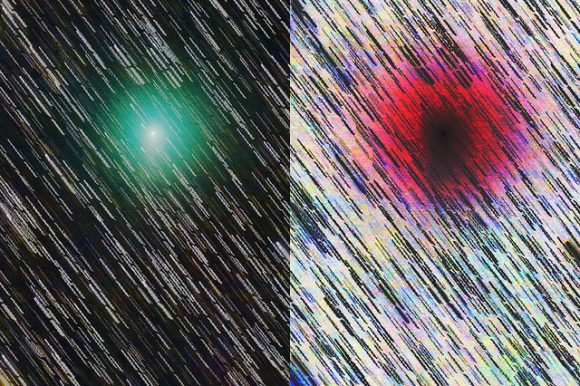
Comet 41P Tuttle-Giacobini-Kresák glows green (left) and shows its true coma and just the hint of a stubby tail in the negative (red) image (right) from March 19th. Image credit and copyright: Hisayoshi Kato
Miss out on comet 45P Honda-Mrkos-Pajdušáková? Is Comet 2P Encke too low in the dawn sky for your current latitude? Well, the Universe is providing us northerners with another shot at a fine binocular comet, as 41P Tuttle-Giacobini-Kresák glides through Ursa Major this week.
As seen from 30 degrees north, Comet 41P Tuttle-Giacobini-Kresák (sometimes called "Comet 41P" or "Comet TGK") starts the last week of March about 40 degrees above the NE horizon at 9PM local. It then makes the plunge below 30 degrees elevation on April 1st for the same latitude at the same time. At its closest on April 5th, the comet will be moving at two degrees a day (the width of four Full Moons!) as seen from the Earth as it slides down through the snaky constellation of Draco.
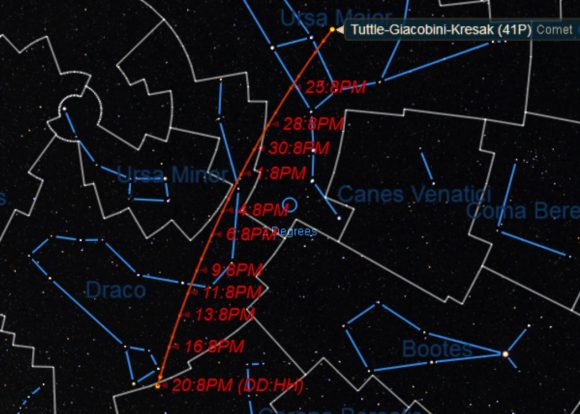
The path of Comet 41P from March 20th through April 20th. Credit: Starry Night.
The comet reaches an elevation of 10 degrees for evening viewers around April 15th, and passes 10 degrees north of another up and coming binocular comet C/2015 V2 Johnson right around the same date. After early April, your odds get better to see Comet 41P Tuttle-Giacobini-Kresák high in the sky at its upper culmination past local midnight towards dawn.
There's another reason to try and recover this comet this week, as the Moon is now a waning crescent headed towards New on March 28th. From there, the waxing Moon begins to interfere with cometary observations as it heads towards the Easter Full Moon on April 11th, pushing efforts to recover and follow the comet towards pre-dawn hours.
First discovered by astronomer Horace Tuttle 1858, the comet was independently recovered by Michel Giacobini in 1907 and L'ubor Kresák in 1951 and its periodic nature was uncovered.
Note: We believe that the "May 3rd, 1858" date given for the discovery of this comet around ye ole Web is in fact, erroneous, as both Stellarium and Starry Night put the comet just a few degrees from the Sun on this date! Perhaps both programs are wrong looking that far back in time... but they're both exactly wrong. Perhaps a bit of astronomical detective work is in order? More to come!
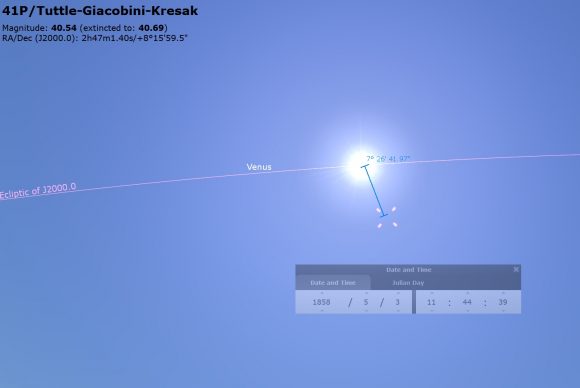
Due for a revision? Here's the position of Comet 41P Tuttle-Giacobini-Kresák on the oft quoted discovery date of May 3rd, 1858... just 8 degrees from the Sun! Credit: Stellarium.
Orbiting the Sun once every 5.4 years, this is the 29th perihelion return of the comet since its discovery in 1858. The comet's orbit takes it from 5.1 AU, out to near the orbit of Jupiter, to a perihelion just 0.13 AU outside the orbit of the Earth. This year's passage is nearly as close as the comet can approach the Earth, with solar opposition also occurring on April 5th. The comet's orbit is inclined about nine degrees to the ecliptic plane. Think of the comet zipping down over the northern hemisphere of the Earth, reaching perihelion as it heads from north to south, then headed back out over the southern hemisphere.
Currently at +9th magnitude, the comet should flirt with naked eye visibility of magnitude +6 in early April. This comet is also worth watching, as it's known for periodic outbursts. Flashback to 1973, and Comet 41P Tuttle-Giacobini-Kresák made an easy naked eye apparition of +4. This is also the closest approach of Comet 41P Tuttle-Giacobini-Kresák near the Earth in our lifetimes, and the closest in the two century span from 1900 to 2100.
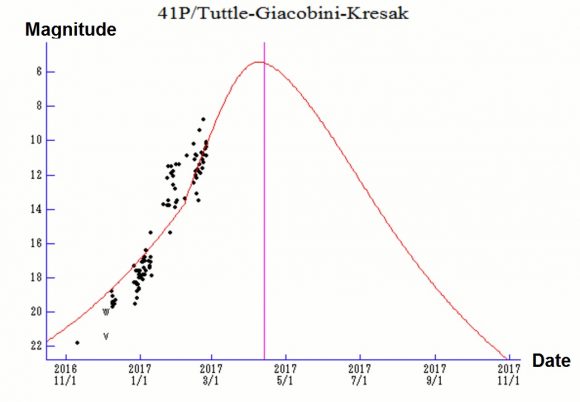
The projected light curve for Comet 41P Tuttle-Giacobini-Kresák. The pink line denotes perihelion, at the black dots mark recorded magnitude estimates. Adapted from Seiichi Yoshida's Weekly Information About Bright Comets.
Arecibo did ping 41P Tuttle-Giacobini-Kresák in early March, but probably won't image the comet near perihelion due to its northerly declination (Arecibo is only partially steerable). They did, however nab a great animation of the twin lobbed Comet 45P Honda-Mrkos-Pajdušáková on February 12th:
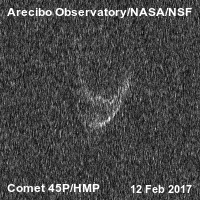
An amazing view: Comet 45P Honda-Mrkos-Pajušáková pinged by Arecibo radar last month. Credit: Arecibo/USRA
That makes two, bi-bulbous comets, if you include Comet 67P Churyumov-Gerasimenko. Are twin-lobbed comets in fact as common as comet-hunters with umlauts in their name?
Here are some key highlight events for Comet 41P Tuttle-Giacobini-Kresák to watch out for. Close passes are less than one degree unless otherwise noted:
March 21st: Photo-op: passes between M108 and M97 the Owl Nebula
March 29th: passes into Draco
April 2nd: Passes near the 3.6 magnitude star Thuban (Alpha Draconis)
April 5th: Passes just 0.15 AU (23.2 million kilometers) from the Earth at 13:30 UT.
April 7th: passes just 22 degrees from the north celestial pole at declination 68 degrees north.
April 11th: reaches perihelion at 1.05 AU (162.7 million kilometers) from the Sun.
April 18th: passes the 2.7 magnitude star Rastaban (Beta Draconis)
April 20th: passes into the constellation Hercules
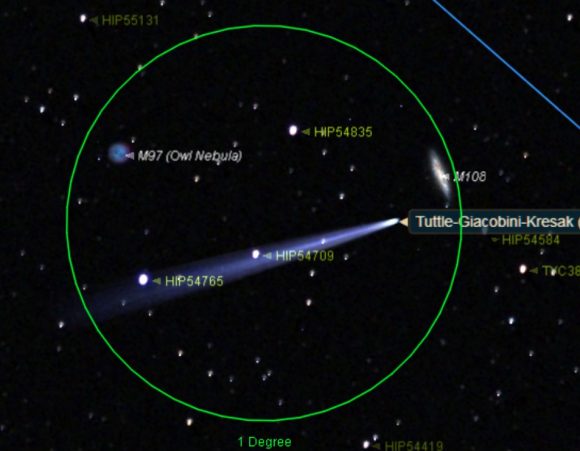
The comet vs two Messier objects: the view on March 22nd at 12:00 UT. Credit: Starry Night
Observing comets is an exercise in patience, as that quoted magnitude is often smeared out over an extended area. Dark skies and a good star chart are key. I like to use binoculars when hunting for comets brighter than +10th magnitude, as it gives you a true (un-inverted both up/down and left to right) view, coupled with a generous field of view.
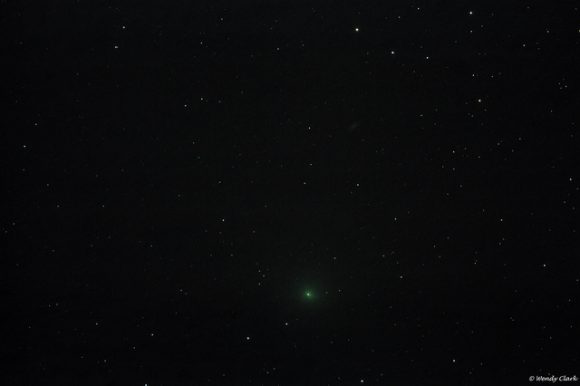
Comet 41P Tuttle-Giacobini-Kresák from March 15th. Image credit and copyright: Wendy Clark.
If Comet 41P Tuttle-Giacobini-Kresák outperforms into the +6th magnitude range or brighter, it could become a fine target to image with foreground objects. We're already seeing some amazing images streaming in, with more to come as perihelion approaches.
Other binocular comets to watch for in 2017 include C/2015 ER61 PanSTARRS (May) and C/2015 V2 Johnson (June).
If Comet 41P Tuttle-Giacobini-Kresák performs at or above expectations (and if no great "comet(s) of the century show up!) it could be the best binocular comet of 2017. Don't miss it!
-Send those images to Universe Today's Flickr page.
-Be sure to read about the brightest comets of the year and more in our 2017 Astronomical Guide, free from Universe Today.
No comments:
Post a Comment